How Data-Driven SEO Strategies Supercharge Client Acquisition

How Data-Driven SEO Strategies Supercharge Client Acquisition
Do you measure your SEO effort? If not, you are just wasting your time and resources. Read this blog to learn about data-driven SEO strategies that heat client acquisition and boost sales.
If you run a website and are struggling with sales growth and client acquisition, it’s time to rethink your SEO strategy.
Data-driven SEO optimization involves gathering valuable data, analyzing the bottlenecks, and resolving them.
In this blog, you are going to learn about data-driven SEO strategies from start to end:
- What is Data-Driven SEO?
- Why is data important to SEO success?
- Where can you find data that can create a data-driven SEO strategy?
- How many steps should be followed to create a successful data-driven SEO strategy?
- How much do you benefit from using data-driven SEO strategies in your sales?
- And what future lies for data-driven SEO?
Whether you are an owner of a business, a marketing professional, an eCommerce store owner, a tech-savvy learner, a web designer, or a developer, this blog will supply you with an extraordinarily in-depth understanding of how to create, implement, and monitor data-driven SEO strategies.
Team up with a top-notch SEO agency on The Manifest.
What is data-driven SEO?
Data-driven SEO is an approach that is always updated on real-time data, analytics, and insights to craft an effective and sharply targeted optimization strategy. This shifts the entire picture from assumptions or general practices into a highly individualized optimization process. It measures metrics such as keyword performance, user behavior, traffic patterns, or competitive analysis to make an informed decision.
This approach enables businesses to discover opportunities, manage effort levels very realistically in that area, and manage progress very realistically. Businesses can achieve possible long-term results, from better search rankings to even more maximized organic visits and even improved conversions, by aligning the search engine optimization strategy against reality. This approach maximizes ROI and impact per effort because it focuses on what works.
As punctuated by the periodic behavior of a company's data, it pretty much updates itself. SEO now becomes less about assumption as the data shows (or neo-practice), but more through an optimization process highly individualized. Now, let’s see the importance of using data in your SEO process.
Why Data Matters for SEO Success?
Regarding SEO, data is the backbone of any successful strategy. It changes vague plans into precise and defined action ones for following measurable results. Here's why data makes that difference as to the SEO success:
- Decisions Found on Evidence
- Identifying Opportunities
- Focusing the Money target audience
- Performance metrics in check
- Improving the User Experience(UX)
- Adaptability to Algorithm Changes
- A Successful Content Strategy
- Measurement and Improvement ROI
1. Decisions Found on Evidence:
It removes the guesswork from the SEO planning process. A business could base its decisions on facts derived from analyzing search trends, keyword performance, and user behavior. From there, it minimizes the wastage of useless strategies since each move will surely be in the direction of growth.
Take tools like Google Analytics and Search Console that tell what drives traffic and what does not.
2. Identifying Opportunities
Data exposes untapped potential. Identifying long-tail keywords that are not very competitive, spot holes in competitors' strategies, and trace patterns in users' search queries. This is precisely what data provides.
For example, if a keyword that sees a lot of action has a competitor winning the rank for it, yet they've not optimized the content for that keyword, that is practically an open door.
3. Focusing the Money Target Audience
Knowing your audience is the fulcrum of SEO success. This is who your visitors are, their demographics, what their search intent is, and how they behave online. Once you have that knowledge, you can create content and strategies to speak to those needs; you will then have increased relevance and conversions.
For example, audience insights gained through SEMrush or Ahrefs can refine your targeting.
4. Performance Metrics in Check
SEO success is not a one-day event or even a week-long process but a continuum. This is where data comes in handy, tracking critical metrics such as organic traffic, bounce rates, time on page, and responses. This instant information can measure how well something is working and make adjustments when necessary. Continuous monitoring keeps such efforts aligned with the objectives.
5. Improving the User Experience (UX)
Search Engines promote websites where exceptional user experience is used. From heatmap data, page speed test, and engagement metrics, insight into potential UX bottlenecks is obtained. Simple problems like slow load time or challenging navigation can improve not only high rankings but they can also engage and keep users satisfied.
6. Adaptability to Algorithm Changes
Search engine algorithms are constantly changing, and agility sharpens your edge above the rest. Data allows one to monitor performance dips or surges; thus, it can help quickly adapt strategy to satisfy a new requirement. For example, Google Core Web Vitals updated page speed with adjustment data to facilitate compliance without guessing the required measurements.
7. A Successful Content Strategy
Content is the lifeblood of SEO; not all content will perform wonders. With the help of data, it becomes clear what type of content your audience engages most with, whether blog posts, videos, infographics, etc. By researching keywords plus performance analysis, you can better shape and expand your content strategy for maximum effectiveness.
8. Measurement and Improvement ROI
Data ensures that your SEO investments pay for themselves. You can document your investments and their results as lead generation, sales growth, or brand visibility to calculate ROI and improve effectiveness. For example, if a certain campaign drives a lot of traffic but produces very few conversions, data can help find the gap and inform you of what to change.
Data can be used to target flexible, successful, and very specific SEO strategies. These SEO campaigns are for client acquisition; hence, they increase sales and ultimately drive the business toward success.
In comparison to traditional marketing, data collection is difficult, but the web mode of marketing keeps you ahead. Additionally, data can be used to track the success of campaigns and optimize them for better results. Data analytics also enables businesses to identify customer trends and predict future campaigns.
Next, we will see some resources where you can find relevant data for improving your website traffic.
Key Data Sources for Data-Driven SEO
Getting the right tools or platforms will give you honesty in running data sources for their purposes. Each can afford a portion of data that would point into the right direction for the processes used. Below are key data resources presented as such:
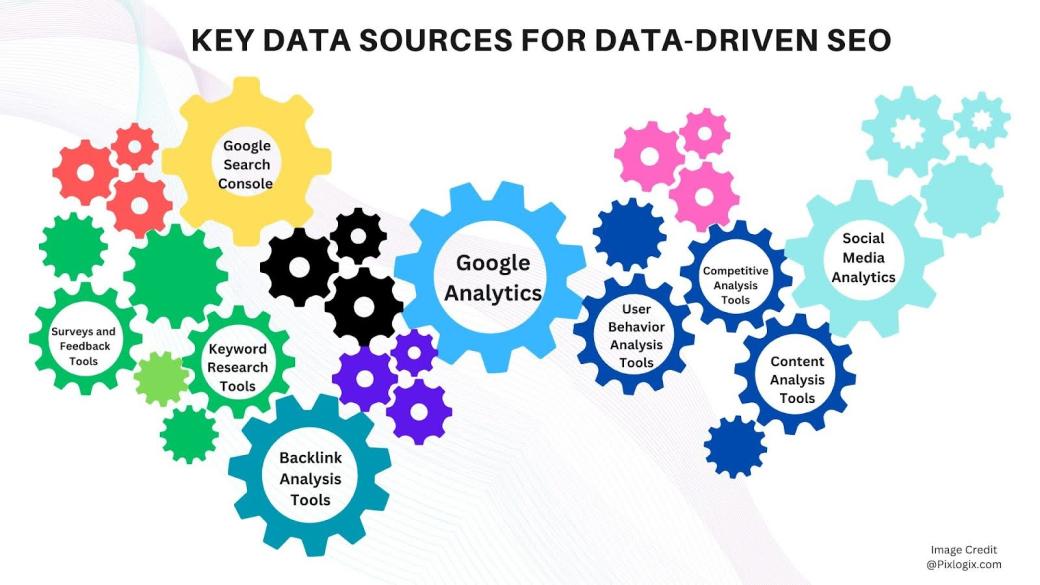
- Google Analytics
- Google Search Console
- Keyword Research Tools
- Content Analysis Tools
- Social Media Analytics Instruments
- Backlink Analysis Tools
- User Behavior Analysis Tools
- Competitive Analysis Tools
- Surveys and Feedback Tools
Tool 1: Google Analytics
Google Analytics analyzes how well your website performs, and what actions visitors take when using it. It keeps track of where the people are from, how long they stay on the websites/pages before bouncing, and other traffic-related segments.
These data will help you identify which goes to a particular page and gets through the entire engagement funnel while also pointing out which areas you might want to optimize. For instance, analyze the 'Behavior Flow' to see bottlenecks on site.
Tool 2: Google Search Console
Search Console - It's critical for tracking your website's visibility within search results. It gives insights into keyword ranking, click-through rates (CTR), impressions, and crawl issues. A performance report gives you keywords with a great potential ballpark for optimizing and climbing the search rankings.
Tool 3: Keyword Research Tools
Tools such as SEMrush, Ahrefs, and Google Keyword Planner are among the number of other keyword research tools. They assist in spotting and analyzing the related keywords, their competition, search volume, and intent.
Those insights will allow you to choose well-aligned keywords that align with your audiences' needs and potential growth opportunities.
Tool 4: Content Analysis Tools
Such platforms as BuzzSumo and ClearScope offer content performance evaluations. Not only that, but they would also point to trending subjects such as what type of content your competition is producing and how they compare to your competitor's engagement metrics. They'll help you write some data-driven content that resonates with your audience.
Tool 5: Social Media Analytics Instruments
Facebook, Instagram, and Twitter have their respective analytic portals to access user engagement metrics, popular posts, and regular traffic referrals to your website. Such information would assist in identifying the content preferences and trends suitable for evolving your SEO strategy.
Tool 6: Backlink Analysis Tools
Backlinks contribute much to successful SEO. Tools like Moz, Ahrefs, and Majestic analyze your backlink profile, finding high-quality and toxic backlinks. This knowledge gives you an overall perspective on the performance of your link-building strategies and helps refine your off-page SEO efforts.
Tool 7: User Behavior Analysis Tools
With heatmap tools like Hotjar, Crazy Egg, and Microsoft Clarity you would get to visualize how the users interact with your site. It shows you their clicks, scroll depth, and navigation paths that help you pinpoint where the UX issues exist and optimize certain pages to enhance engagement.
Tool 8: Competitive Analysis Tools
Competitor tools such as SpyFu, SimilarWeb, and SEMrush allow you to benchmark your performance against the industry competition. They tell you what your competitors rank for, their keyword strategy, backlink profile, and traffic source. All this gives you actionable insight to get ahead.
Tool 9: Surveys and Feedback Tools
This can be done through tools like SurveyMonkey and Typeform for collecting direct responses from audiences. With these, you can actually find out what preferences, pain points, and expectations users have so that you can fine-tune your SEO according to what your audience wants.
These are some of the data sources that you can use in creating a solid SEO campaign for your business to be highly visible and, consequently, generate traffic and conversions.
Bonus tip: Adopt a strategy where you engage the different tools so that you make sure you are going to cover all grounds in SEO. Thus, it keeps you relevant and competitive.
Let us now consider how you can implement data-driven SEO for your business.
Don't worry; you needn't wait any longer. We'll give you a detailed step-by-step guide on how to create a data-driven SEO strategy for your business.
5 Steps to Develop a Data-Driven SEO Strategy
The first thing necessary for a strong foundation for a data-driven SEO strategy is the setting up of clear goals and measurable key performance indicators (KPIs).
- Define Clear Goals and KPIs
- Comprehensive Keyword Research and Analysis
- Optimize Content Based on Data Insights
- Use Technical SEO with UX
- Performance Evaluation and Enhancement
Step 1: Define Clear Goals and KPIs
Your business priorities should be well understood. Are you looking to increase organic traffic to your site, generate leads, or are you focused on driving sales through e-commerce channels? These objectives will ultimately guide your entire SEO strategy.
Then, set specific, measurable KPIs such as:
- Rate of growth for organic traffic
- Conversion rates
- Bounce rate improvement
- Average time on page
- Keyword rankings
These metrics ensure that you can evaluate the success of your efforts.
Then, define time frames within which goals should be achieved and establish clear deadlines for milestones, such as aspiring to increase organic traffic by 20% in the next six months.
These goals help ensure that all team members; especially the content creators who spend their energy working towards the same improvement. That will help create a level of transparency among their respective teams about where things stand.
Because SEO changes over time, evaluate the practicality of your goals periodically using data, or revise them based on performance and new opportunities.
Step 2: Comprehensive Keyword Research and Analysis
Keyword research is the foundation upon which an effective data-driven SEO strategy should be built. It also signifies the beginning phase of the implementation process concerning SEO strategy against all odds. Without in-depth keyword research of your market, any forthcoming SEO efforts are meaningless to you.
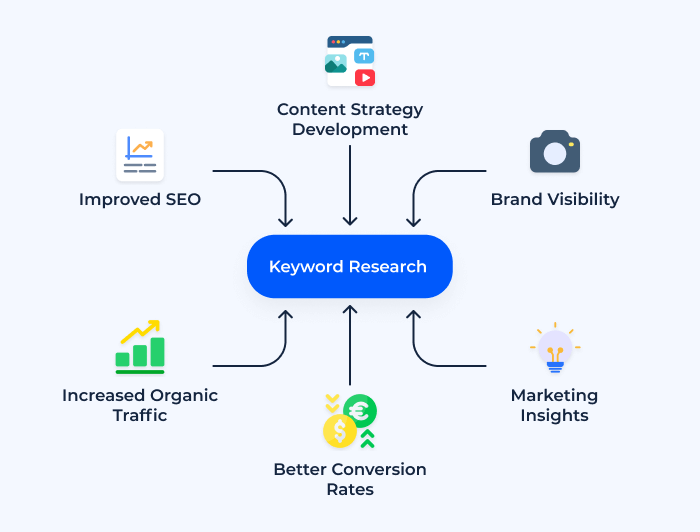
Source: Sitechecker
Therefore, keyword research has to be thorough to find the most prosperous avenue for your website.
Let’s understand the process of keyword research and analysis in depth.
Know the Intent of Query Makers
You need to be informed about keyword intent to determine the keywords. Pay attention to user-intent action keywords like buy, hire, and quote. These suggest the readiness for conversion.
The aforementioned example, affordable web design services, shows users searching for specific solutions.
Long-tail Keywords
Next, Long-tailed keywords are less competitive and specific and generally target niche customers. Hence, they have a better conversion rate because when the exact need matches with upper-these, these keywords are signified.
For example, instead of targeting "SEO services," you would target "data-driven SEO services for small businesses."
Analyze Content Gaps and Identify Opportunities
Find the keywords your competitors rank for, but your site does not. For this research task, you can get help from paid tools like SEMrush, Ahrefs, or Ubersuggest. Content gap analysis tells you what hitherto unexploited golden opportunities you could create value and new assets through meaningful, targeted content that serves the audience.
Prioritize Keywords based on the Business Goals
All keywords will not have the same value. Give priority to the keywords that drive the business goals like improve sales from high-margin products or increase visitors to a specific service page. Look for metrics such as search volume, keyword difficulty, and relevance to your audience.
Monitor and Adjust for Data
The performance of a keyword may change with time due to the competitive landscape or changing search trends. With tools like Google Search Console and Rank Tracker, you are constantly monitoring your rankings and traffic and perfecting your strategy concentrating on the better-performing terms.
These keyword research and analysis practices allow you to become visible in targeted user queries. The more visibility you get, the higher your chances of converting. To learn the whole process of Keyword research, you can use this rhyme.
Keyword research drives SEO's might,
Find high-intent terms to get it right.
Long-tail gems and content gaps to explore,
Refine with data to achieve even more!
Share with your team to get all the right keywords searching for your website.
Then, after researching those keywords, one moves forward to working on those keywords.
Step 3: Optimize Content Based on Data Insights
You may know that search engines do not care about the keywords you are targeting; they just want a nice piece of relevant content for their users. Hence, in order to make your keyword research effort worthy, create a website that writes and optimizes its content accordingly.
With insight from analytics tools like Google Analytics or Hotjar, identify the high-performing and underperformers, look at click-through rate (CTR), bounce rates, time spent on pages, and other yardsticks.
After doing that exercise, rewrite the titles and meta descriptions for the low CTR pages to lure more clicks. Organize content in an easily readable format through the apostolate of headings, sub-headings, and bullet points. Address drop-off points with even more relevant or interesting information.
Note: Refresh previously written insights, repurpose popular posts, and develop seasonal content. Regular data leverage will ensure consistent improvement and relevance.
Step 4: Use Technical SEO with UX
Both are different aspects of the same coin - Technical SEO is concerned with the behind-the-scenes aspect of a website, which an SEO understands; on the other hand, UX keeps the well-being of the user in focus.
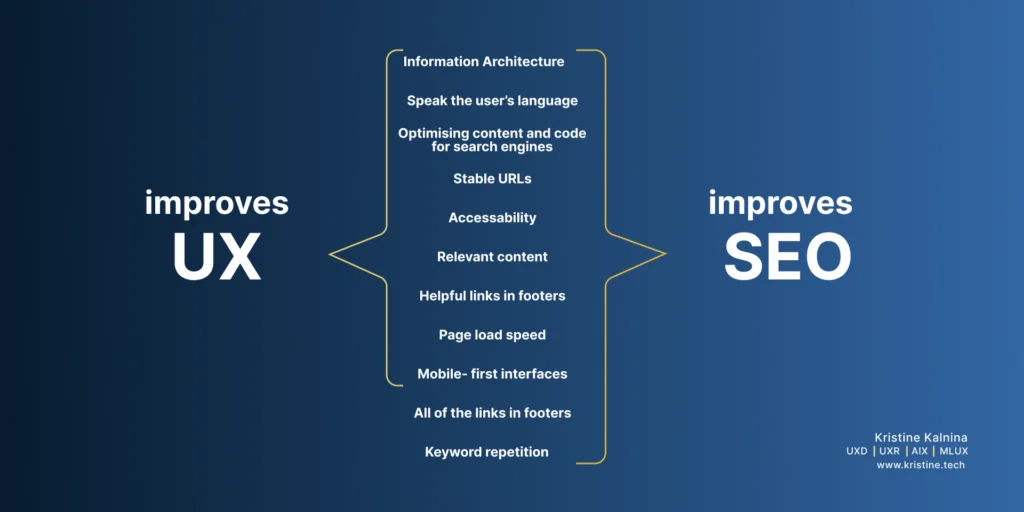
Source: UXMag
Both are indispensable for better ranking of a website as well as for a user-friendly experience. Let us brainstorm on this one by one.
Part 1: Technical SEO
Technical SEO is really how you maintain the "behind-the-scenes" work ensuring that your site is search-engine-friendly. It has to do with making sure that your website is discoverable and understandable by Google, and other search engines, and that it ranks your content.
The most awesome-looking pages ever created by your fantastic site will be wasted if the search engines have trouble with your site. Simple and clear: make your website as good an environment for robots as the beauty of its homepage makes it for humans.
You can proceed from the basic principles of Technical SEO to the high performance of your website for search engine crawlers:
- Website Speed
- Mobile Friendly
- Structured Data (Schema Markup)
- Clean URLs
- Broken Links
- Secure Website (HTTPS)
- XML Sitemap
- Robots.txt
- Canonical Tags
- Internal Linking Structure
- Core Web Vitals
- 404 Error Pages
- Hreflang Tags (for multilingual sites)
- Site Architecture & Hierarchy
These are the key aspects of top-notch technical SEO optimization.
Part 2: User Experience (UX)
Let's move on to the area of user experience (UX) and how it regards the visitors' interaction with the website. A nice user experience allows the visitor to find what is sought easily while having a great time on your site.
Then think of UX as the furniture and interior design of a house. An easy-to-navigate environment fulfills the above definitions by being comfortable and making people feel welcome. Exposes people to much beauty emulating love in the sight-pleasant and usable by design.
The key features of a well UX designed website are as follows:
- Intuitive navigation
- Readable and legible content
- Clear Call-to-Actions (CTAs)
- Accessible design for those with disabilities
- Engaging visuals
- Responsive website layout
- Minimal steps for an error-free user journey
- Trust signals
- Avoidance of annoying pop-ups, ads, or interstitials that disrupt the user experience.
- Smooth, simple forms
- User feedback and testing
Engaging these user experience design practices will undoubtedly guarantee a seamless and pleasurable experience when visitors visit your website.
It's truly an elaborate and tedious activity to do, but you must do it right for the best results. You will also not deny that you will require some technical assistance for the talent-now technical SEO optimization as well as excellent user experience on your website.
The last but by no means least step in our strategy for data-driven SEO.
Step 5: Performance Evaluation and Enhancement
For faster yet better results, continuous monitoring, and iterative optimization is the key to sustaining as well as enhancing the effect of your data-driven SEO strategy. Your actions remain along your set goals by regular tracking, while adjustments keep your strategy flexible and field-wise competing.
Do you recall those tools we spoke of earlier?
We'll now use those findings in this section to understand what it may be a possible gap.
Note: For the sake of following along in this process, we are only using Google Analytics and Google Search console tools. You may have other tools, but the same process applies.
#1 SEO Audit
Carry out a thorough SEO audit note down all possible technical issues (for example, the slow site speed, and broken links), content gaps, and opportunities. Use tools like those available from Google Search Console, Ahrefs, SEMrush, or Screaming Frog. You can do this either quarterly, half-yearly, annually, or at any time before applying changes to your website.
#2 Keyword Ranking Tracker
This is a consistent process; in the first two months, it has to be on a weekly basis and then can be shifted to monthly checking for keyword rankings.
#3 Analyze website traffic and user behavior
To do that, utilize Google Analytics to measure traffic on the website in terms of user behavior such as; bounce rates, time spent on the page, and conversions. Look for trends in high-performing pieces of content that should be tracked and monitored over time to see what should be improved in terms of performance. This can be done weekly for the early months, and then perhaps shift to a monthly frequency of traffic and user behavior analysis.
#4 Determine Technical Problems (Site Health)
Make sure to keep track of the new technical SEO issues, crawl errors, broken links, or mobile-friendliness, every month, to make sure there are no instances of events missed.
#5 Content Optimization and Updates
Continual updates should be done to old content to keep it current, relevant, and optimized for target keywords. New and additional content or blog posts may be initiated to address gap content areas identified. The best way to optimize content is monthly for updates; and quarterly for adding new content.
#6 Backlink Monitoring and Acquisition
Check monthly for the first 3-6 months, and then quarterly is the recommended frequency to track how many and of what quality the backlinks are pointing to your website. When you get results, acquire high-quality backlinks through outreach, guest posts, etc. to fill the website position gap.
#7 Evaluate and Optimize User Experience (UX)
Optimizing the user experience is not a very frequent subject. However, to avoid any possible mistakes a half-an-year testing or testing after a very major side update is good.
#8 Check Conversion Rates (CRO)
All elements are then reviewed quarterly to study the conversion from form submission to CTA button placements to analyze optimal conversion performance and tracking.
#9 Refine and Adapt Strategy Based on Data
Quarterly reviews for major adjustments and annual reviews for an overall strategy review would be ideal. Analyze all data collected from Google Analytics, Search Console, and any other SEO tools that have been used. Adjust the SEO strategy based on what's working, such as targeting new keywords, and improving poorly performing pages.
Bonus tip: The key to tracking progress and accountability is consistency. So, share performance metrics with your team such as traffic trends, and conversions, and ROI-measure the effectiveness of your overall strategy, and refine goals. And configure automatic performance alerts for critical metrics like drop-offs or crawl errors in traffic.
Heuristic definition of this iterative process to keep your strategy proactive, competitive, and aligned with your business objectives.
Congrats on making it this far! You've done about 70% of writing the blogs and have the most useful pieces of information you'll need.
The next segment will give you tips on how to help your client base grow through Data-driven SEO.
How Data-Driven SEO Improves Client Acquisition
Companies that take a data-driven approach to SEO allow their clients to find their services effortlessly, engage with them meaningfully, and convert them into clients. This is because companies can get real-time insights so that they can mold their strategies around customer needs and market dynamics.
Here is how data-driven SEO supercharges client acquisition:
Tip 1: Niche Targeting with High-Intent Keywords
Tip 2: Enhanced User Experience (UX) through Behavioral Data
Tip 3: Proper Content Strategy with Audience Insights
Tip 4: Competitor Analysis for Strategic Positioning
Tip 5: Attract Nearby Clients with Local SEO
Tip 6: Measure ROI and Optimize for Higher Acquisition Rates
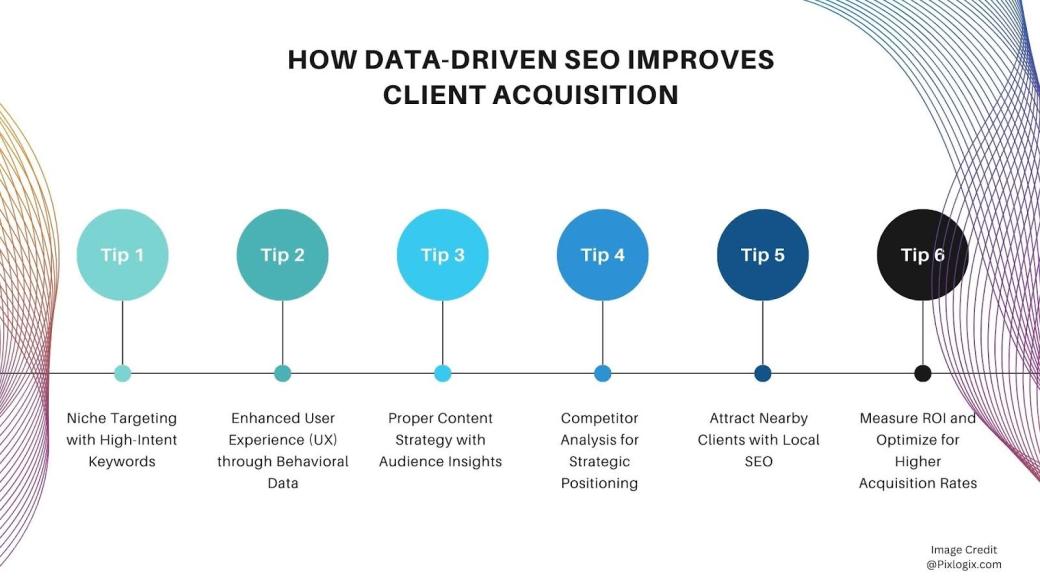
Tip 1: Niche Targeting with High-Intent Keywords
Data-driven SEO tracks and prioritizes keywords that typify user intent, such as 'hire', 'buy', or 'get a quote'. Such keywords will attract people looking for solutions themselves, so the quality of leads will be higher. For example, optimizing for "best software solutions for small businesses" will focus on users in the process of making a buying decision critiqued by someone.
Tip 2: Enhanced User Experience (UX) through Behavioral Data
In understanding the dimensions of improvement and correcting pain using several measured data like bounce rates, session duration, click patterns, etc. Improved navigation, faster load times, and mobile responsiveness ensure that users stay engaged, increasing the likelihood of conversions.
Tip 3: Proper Content Strategy with Audience Insights
By getting these insights through tools like Google Analyst or SEMrush, businesses can know what their audience may be interested in, like searching usually on certain topics or trending keywords. Developing content with great relevance for the audience would then be created for easy attraction of potential clients.
Tip 4: Competitor Analysis for Strategic Positioning
The data-driven SEO enables the company to know where the competitors have strengths or weaknesses through tools such as Ahrefs or SpyFu. After discovering the weaknesses of the competitor, businesses can develop unique, client-based content or services that are completely different from competitors, paving the way for being future leaders in the niche.
Tip 5: Attract Nearby Clients with Local SEO
For businesses that have a very local market, data-driven SEO attempts to make the use of the very location-specific keywords so much of the listing would be based on Google My Business. Reviews, local backlinks, and location pages make it easy for a business to be seen in local search results, increasing foot traffic visits and inquiries because of the visits of nearby clients.
Tip 6. Measure ROI and Optimize for Higher Acquisition Rates
Data-driven is the tracking of the ROI of a campaign via metrics such as conversion rates, sources of leads, and cost of client acquisitions. Frequent checking on such data helps businesses ensure that they optimize their methods by shifting resources to significantly effective channels and bringing in more clients.
This is where SEO strategies complemented by precision data would create a difference for small businesses in attracting and converting customers. Data-driven improved optimized effort, increased visibility but leads measurable impact on client acquisition.
Of all the eCommerce owners reading this next segment, it is for those who are curious about how data-driven strategies can increase their website sales.
Influence of Data-Driven SEO on Sales Growth
There are various reasons for eCommerce sales like your website, product, user experience, and offers. So, a business and website review is a good way to start. If you find all things are good, move to collecting data for your SEO strategy. Once you get all the information about your online store and customers now follow these tips to enhance your sales performance:
Tip 1: Optimization of Conversion Rate
Tip 2: Retention through Relevant Content
Tip 4: Improved User Experience and Engagement
Tip 7: Long-Lasting Business Continuity
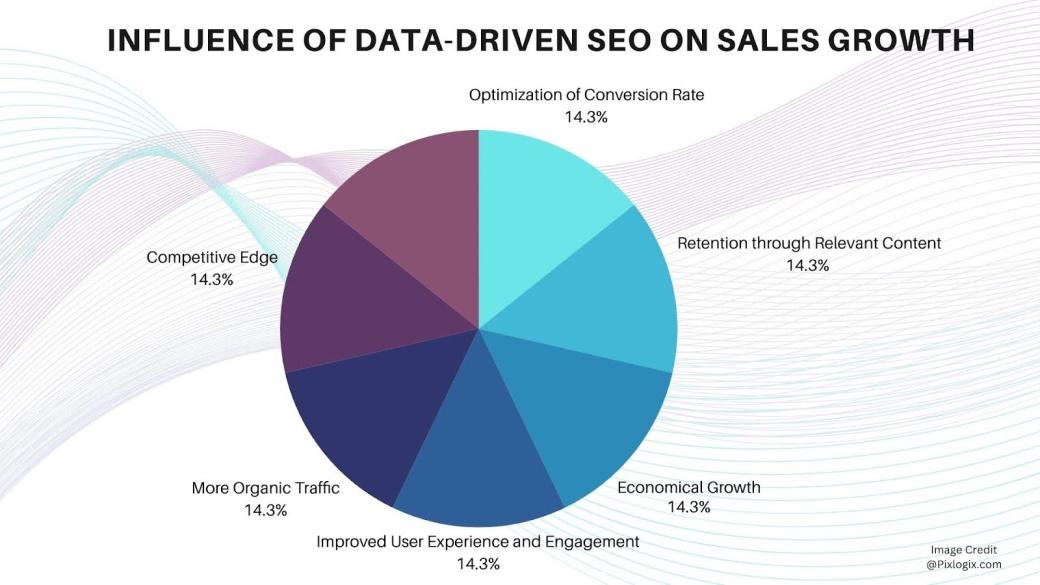
Tip 1: Optimization of Conversion Rate
Data-driven SEO improves conversion rates by bringing the right audience to the right landing page. Understanding user behavior improves landing page layout and personalized content for easy purchasing, for instance, by making it easier for someone to find a piece of content. This creates a greater interaction level by bringing more qualified traffic to the path more intuitively and successfully, resulting in sales growth and future development.
Tip 2: Retention through Relevant Content
Data-driven SEO will be what holds them in place. Based on an analysis of customer behavior, creating customized content will increase loyalty. Market-specific email relaying messages based on data will build a relationship that would end up with the customers readily returning on their own and further boosting long-term sales.
Tip 3: Economical Growth
Data-driven SEO makes growth cost-effective since it avoids wasted resources on strategies that do not yield fantastic results. By analyzing performance, businesses optimize ad spending, minimize wastage, and maximize return on investment, driving growth without unnecessary offenses.
Tip 4: Improved User Experience and Engagement
Data-driven SEO improves user experience by identifying issues with slow page loads and fixing them. Thanks to mobile optimization and easy navigation, users can have a seamless experience while browsing. For this reason, visits, conversions, and engagement increases.
Tip 5: More Organic Traffic
More organic-targeted traffic through data-driven SEO comes because of the right keywords and optimizations to content. Analysis of performance data will give businesses more visitors to rely on as they generate backlinks giving them the findability to bring these traffic back in.
Tip 6: Competitive Edge
Companies can figure out gaps and opportunities for improvement and fine-tune their approach through a careful analysis of the competition's SEO strategy. Data-driven insights work well to keep eCommerce businesses on top of trends whereby they remain well-placed relative to their competitors.
Tip 7: Long-Lasting Business Continuity
Concerning long-term business sustainability, data-driven SEO makes growth over the long term continuous. Long-term, this means that businesses remain relevant, scalable, and adaptable in the face of changing market trends to ensure long-term success and sustainability.
Kudos to you, you are a professional reader.
You have learned the best things concerning acquiring knowledge regarding data-driven SEO strategies and how they work in this blog. Next, you will see what result would be expected from a properly data-directed SEO.
8 Trends to Keep an Eye Out for: Future of Data-Driven SEO
Yes, every single year brings several updates. And, of course, there were several changes and improvements when in the declaration of the AI era; the strategies and ways for data collection were innovated and developed. This list will mention a few trends in data-driven SEO.
- Machine Learning and AI Integration
- Voice Search and Natural Language Processing (NLP)
- Predictive Analytics
- More Advanced Measures of User Experience
- Cross-channel integration
- Mobile-First Indexing
- Greater Emphasis on Local SEO
- Blockchain Technology
1. Machine Learning and AI Integration
The other phenomenon that changes data-driven SEO is artificial intelligence and machine learning. This technology will use data-driven analysis that detects trends and insights more quickly, obtaining a deeper understanding of user behavior.
Tools for optimization will automate and give real-time information in the adjustment of content and changes in SEO strategies almost immediately to help businesses stay ahead of changes in such people's behaviors while improving performance. This will enable SEO efforts to be much more proactive and responsive.
2. Voice Search and Natural Language Processing (NLP)
SEO is now adapting to a new reality. With the increase in the number of voice-activated devices, so is the search entry changing. Queries should typically be longer and will use a more natural language phrase, requiring content that speaks as people do.
Natural Language Processing (NLP) will be important for businesses as it aims to optimize content for this new mode of spoken queries: voice search. Content will be more conversational so that it meets the needs of the voice users when searching.
3. Predictive Analytics
It is a predictive analysis of Predictive Analytics that will change everything about SEO because they can predict trends and establish changes before they actually appear. These businesses, through predictive models, can identify and anticipate the changes in search behavior and market demand, thus taking strides ahead of competitors. With historical data to interpret user patterns, content creation, and marketing strategies are refined by delivering or pushing more relevant content and messages towards meeting user needs and enhancing engagement.
4. More Advanced Measures of User Experience
Dwell time, interactions with pages, and overall satisfaction will become ever more important in determining an SEO successful outcome, given the mounting emphasis on user experience by search engines. Data-driven insights will be used to translate matters into web and usability improvements for making content engaging to access, thus creating performance- and content-optimization opportunities for businesses in both directions, SEO-wise and user-wise.
5. Cross-channel integration
SEO now aligns and integrates more with other digital marketing channels, including social media and content marketing, as well as email campaigns. Such integration will provide the seamless experience you expect between these platforms. A complete analysis of such data from several outposts would allow the management of the enhanced value created through engagement efforts targeting customers more appropriately and improving the overall effectiveness of marketing processes.
6. Mobile-First Indexing
The content under this heading is the crux of mobile-first indexing. The focus is to develop websites for mobile devices in an advancing trend, which will include optimization of mobile pages' speed, usability, and overall performance to enhance user experience and thus create a data-driven approach. Responsive design is where the key will lie to shape websites adaptively to different screen sizes, an aspect that boosts SEO rankings and user satisfaction.
7. Greater Emphasis on Local SEO
Mobile search is going the extensive way now and thus local SEO matters to sell products, services, or even brands to the people who are near them. Hyperlocal targeting will enable the very specific geography to be pinpointed by the businesses and thus make their names line up for the applicable local inquiries. With local data for nearby customers and an understanding of user behaviour, businesses can personalize content and optimize it in particular locations so as to gain more footfalls and conversions in their local markets.
8. Blockchain Technology
Then Blockchain technology comes in. Blockchain can potentially revolutionize the SEO domain by giving trust and security to the data. With a decentralized perfection in the nature of blockchain, new ways come about to manage and prove SEO data on it, which gives more trust and accountability. It could also change how search engines evaluate content, backlinks, and other ranking clues, so SEO conditions will become much more open and trustworthy.
Essential tools are Google Analytics, Google Search Console, keyword research tools, backlink analysis tools, content optimization tools, and social media analytics platforms. Data gathering and analysis would be perfect for making optimal SEO strategies.
FAQs About Data-Driven SEO
Q1: What tools are really effective for data-oriented SEO?
Data-driven SEO uses real-time data and analysis to guide its decisions to have a flexible and adaptable strategy. In contrast, traditional SEO tends to be more on the general best practices and assumptions. It lacks the information that continuous monitoring of data will provide.
Q2: How does data-driven SEO differ from traditional SEO?
On the other hand, data-driven SEO uses real-time data and analytics to inform decisions, allowing for more precise, adaptable strategies. Traditional SEO, on the other hand, relies more on general best practices and assumptions, lacking the insight provided by continuous data monitoring.
Q3: What kind of data should I look for effective results through SEO?
Focus on organic search data, keyword performance, user behavior (bounce rates, dwell time), backlinks, conversion rates, and technical performance metrics. This data identifies areas for optimization and guides decisions in strategy.
Q4: Is data-driven SEO good for content marketing?
Indeed, data-driven SEO improves content marketing in terms of discovering what resonates with your audience, optimizing high-performing keywords, and ensuring content matches user intent to boost engagement and bring more visitors to your site.
Q5: What are the high-intent keywords and why do they matter?
High-intent keywords are keyword searches that deny the user the ability to do an action like buying something. That is why they're so important; they're the ones you intend to target further down the sales funnel and need a greater chance to convert and improve ROI.
Q6: How often should I check my SEO data?
Look at your SEO data at least once a month, but you could do it more often to see medium-term trends and be able to adapt quickly. Ensure to continuously monitor your strategies to always deliver effectiveness and relevance to any changes in the market.
Q7: The effect of user experience on data-driven SEO
User experience (UX) highly influences search engine optimization because search engines will always favor sites with a good experience. Insights from the users' behavior data will optimize site load speed, navigation, content relevance, and mobile-friendliness to improve engagement and rankings.
Q8: Will data-driven SEO be the future?
Certainly, it will be quite relevant because it goes hand-in-hand with the evolving algorithms and how people search in different ways with the introduction of technology. Most companies will utilize data to adapt to new trends in order to give their businesses an edge in optimizing future SEO requirements.
Future-Proof Your SEO Strategy with Data-Driven Insights
A data-driven SEO strategy is the right answer to the problems of wasting leads and flicking sales. Understand the power of data; utilize it to create and deliver targeted SEO campaigns that will work on boosting exposure for your website and the conversion of visitors to sales.
The application of the right strategies from the best accurate insights guarantees a good ROI, greater client acquisition, and broad-based growth of the business. This is a blog that will guide you on how to develop, implement, and optimize data-driven SEO strategies, whether you are a businessperson or a digital marketer.
Remember, if it is done right, your website will be a powerful tool to pull in clients and also sell them.
About the Author
Samir Bhimbha is the Founder & CEO of Pixlogix Infotech Pvt. Ltd. which offers web and app solutions to fulfill business's online needs and help to improve their online presence with many clients in the USA, Europe, Australia, and more. He is a skilled entrepreneur, web designer, developer, and team leader who can handle every situation. With 15+ years of experience in UX/UI design and web development, he is leading a team of IT professional talents.
